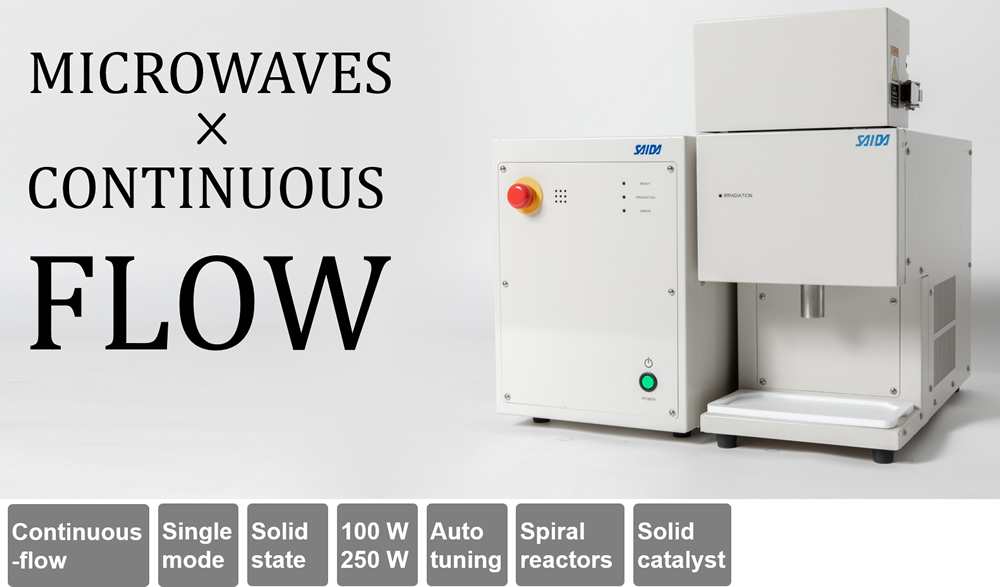
Outline
Our flow-type microwave reactor is a system composed of a microwave unit with a pump unit. In this reactor, SAIDA’s microwave technology can achieve rapid and uniform heating of a flow channel. Therefore, this system not only provides advantages over conventionally-heated flow reactors, but also allows a method to scale-up reactions normally conducted in a batch-type microwave reactor. Furthermore, the system allows safe operation at extreme conditions (Max. temperature: 230 °C, Max. pressure: 2.5 MPa), because the reaction field is more compact than a batch-type reactor and internal pressure/temperature are continuously monitored. SAIDA FDS’s flow-type microwave reactor supports the research and development of the pharmaceutical companies and special chemical companies.
Features & Benefits
1. Rapid heating for flow chemistry applications
2. Scale-up of microwave chemistry
3. High temperatures & high pressures for chemical reactions (230 °C & 2.5 MPa)
4. Safe operation under high temperature & high pressure
Specification
| Model name | FMR-100S | FMR-250S |
|---|---|---|
| Overview | 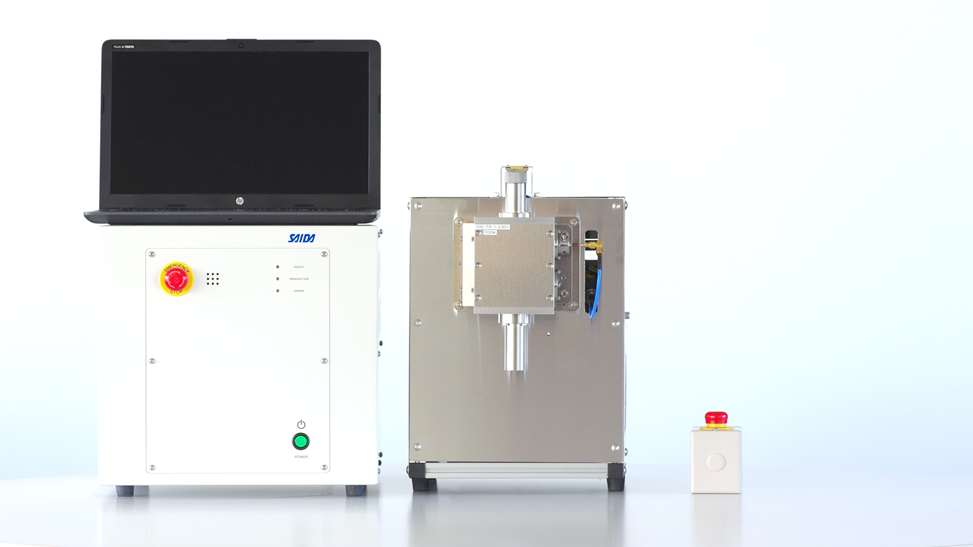 |
 |
| * Pump unit: option * PC for control: sold separately |
||
| Maximum microwave power | 100 W | 250 W |
| Cavity vertical length | 100 mm | 200 mm |
| Maximum temperature | 230℃ (FMR shuts down at 300°C) | |
| Maximum pressure | 2.5 MPa when using a pressure sensor (FMR shuts down at 3.0 MPa) | |
| Cavity exchangeable | 〇 | 〇 |
| Software | Power control, temperature control, variety of log function (temperature, input power, reflect power, microwave frequency, pressure data, etc.), Peak Finder (simple display of S11 and S21 parameters) | |
| Size: Control unit Size: Irradiation unit |
350Wx465Dx345H(mm) / 20(kg) 220Wx420Dx465H(mm) / 19(kg) |
350Wx465Dx345H(mm) / 20(kg) 290Wx495Dx533H(mm) / 19(kg) |
| Temperature measurement | Thermocouple or Radiation thermometer | |
| Option | Pressure sensor, Exchangeable cavity, Spiral reactor tube, Radiation thermometer, Back pressure regulator (BPR), LC pump, ETFE tube (OD:1/16 inch), fitting (No.10-32UNF) etc. | |
FMR system example
The FMR series can be operated as an independent continuous flow system in combination with options. An example of system consisting of FMR-250S and two pumps is shown below. The pressure sensor works in conjunction with FMR. The pressure sensor can be used to display pressure trend graphs on a PC screen, record pressure data, and provide a safety mechanism for the pressure.
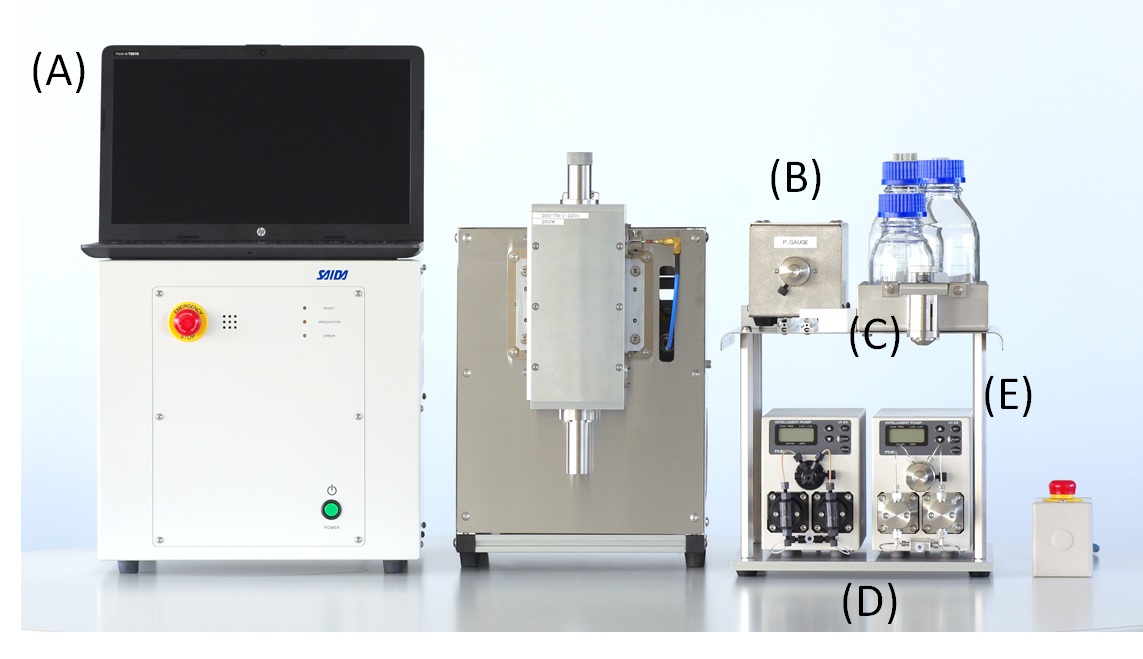
Fig. System example of FMR-250S with options
(A) PC with software installed
(B) Pressure sensor
(C) Back pressure regulator
(D) LC pump (left) head material: PEEK, (right) head material: SUS
(E) Stand
Accessories
SAIDA FDS has the wide variety of reactor tubes in volume and geometry to support high pressure, solid catalyst, high temperature and residence time for the need of continuous flow-microwave reactor.
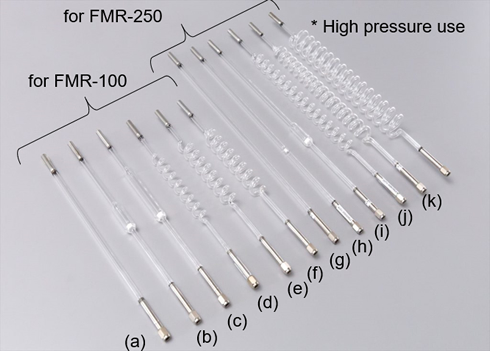
Fig.2 Reactor tubes for FMR-100 or FMR-250
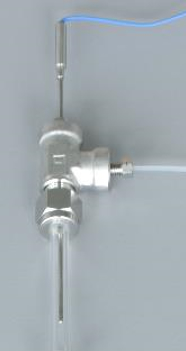
Fig.3 T-coupler with thermocouple
Table Reactor tube details for flow-type microwave reactor(PDF:42.4KB)
Glossary
For Continuous-flow:
This flow-type microwave reactor is a continuous-flow use only. It means the reactor tube for batch-type cannot be use.
Single-mode:
The electromagnetic-mode of microwave reactor is categorized in two groups as the multi-mode and single-mode. Multi-mode system has some electromagnetic-modes in the system (for typical example: a domestic microwave oven). Single-mode system means that only specific electromagnetic mode exists in the system therefore single-mode system is adopted for the reproducibility. Furthermore, the single-mode system can be categorized in two a resonator type and a transmission path type. A resonator type is required the resonation of microwaves in the system, and it is characterized as higher electric field rather than transmission path type. Our flow-type microwave system is adopted by single-mode consists a resonator to achieve rapid and uniform microwave heating through a flow channel.
Solid state device:
A microwave power source is commonly used an electric tube type (magnetron etc.) or solid-sate type. The benefit of adopting magnetron is significantly higher output power with lower cost than solid-state type. A disadvantage of magnetron has some variable factors of oscillating microwave frequency and is difficult to control the frequency. The feature of frequencies oscillating by magnetron includes some frequencies except for a center frequency. On the other hand, a solid-state type is characterized as a single frequency and the controllability of oscillating frequency.
100 W / 250 W:
The output power of a domestic microwave oven is approximately 700 W, 1000 W or 1500 W. The output power by solid-state type of our flow-type microwave reactor is maximum 100 W or 250 W. However, the output power by magnetron is the sums of distributed frequencies with each output power. In contrast, the oscillating "single frequency" by our system has maximum 100 W for FMR-100 model and maximum 250 W for FMR-250. Therefore, we consider that the cost performance between a magnetron and solid-state type in a single frequency is no difference significantly. Our system can achieve rapid and uniform microwave heating by four technologies (1) single-mode resonator (2) solid-state device (3) auto-tuning system (4) spiral-reactor tube.
Auto tuning:
The resonance frequencies in a resonator will be changed by increase in temperature of a load. Our auto-tuning system maintains the optimal resonance frequency automatically.
Spiral reactors:
Our spiral reactor tubes (we have this patent) are adopted to increase the residence time under microwave irradiation, and to help the microwave resonance within the ISM (Industry Science Medical) band.
Solid catalyst:
The one of benefit of continuous-flow synthesis is able to fix a solid catalysis into flow channel. For continuous-flow synthesis using solid catalysis under microwave irradiation, we have developed the dedicated reactor tube with a quartz filter.
FAQ
Q1: How long does it take the lead time?
A: Normally, it takes about 3 months for manufacturing and plus transportation time after receiving your purchase order.
Q2: Is it possible to transport by air?
A: Yes, you can choose either by boat or by air.
Q3: What transportation terms can we choose?
A: Usually we quote to customers as EX factory, if you wish we will also quote as FOB Japan, CIF port and CIP airport.
Regarding more detail for ‘Incoterms’, please visit following site of ICC (International Chamber of Commerce).
Q4: Is it possible to see the flow-type microwave reactors outside of Japan?
A: Yes, you will be able to see them in the United States and Europe, please kindly contact Pacific Microwave Technologies.
http://pacificmicrowave.com/
Also in Germany, both FMR-100 and FMR-250 stay at the laboratory of Dr. Joshua P. Barham (see his Lab: http://www-oc.chemie.uni-regensburg.de/barham/, in Universität Regensburg, Germany).
Q5: Can we rent the flow-type microwave reactor?
A: Only FMR-100 is available for renting in the US and Japan.
Q6: How much voltage is needed for the reactors?
A: It needs AC100 V, 50 Hz/60Hz for FMR-100 and FMR-250.
